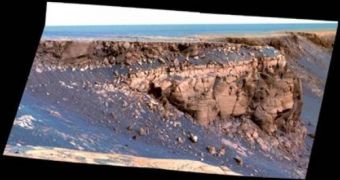NASA's Opportunity Rover is finally set to descend into the 230-foot-deep Victoria Crater on Mars to turn the page of the Red Planet called "a geologic history book" after spending the last couple of months making a clockwise trip around the crater's rim, heading for a breach called Duck Bay, said mission officials.
The decision was communicated by NASA, after months of debate on the subject. The decision was extremely difficult to make because of the risks involved and the agency doesn't exclude the possibility of losing the rover in the deep crater, if it rolls over, slips or gets stuck in a dark place, where sunlight won't reach its solar panels, thus leaving it "dead in the desert."
Alan Stern, NASA's associate administrator of the Science Mission Directorate in Washington made the announcement saying that "we've made a decision to authorize the rover to descend down into Victoria Crater," noting that the risks had been thoroughly examined.
The entry point into the half-mile-wide Victoria Crater will be the Duck Bay, the smoothest slope found by scientists, after Opportunity circled the entire crater for the past months and the descent has been authorized for the beginning of July. "Perhaps the 7th or 9th of July," said John Callas, MER project manager at NASA's Jet Propulsion Laboratory in Pasadena, California.
Like a child by the pool for the first time, the rover will first move down the slope for a few feet and will back out, to see if there's any danger of slipping or sliding. What NASA scientists can't anticipate is a mechanical malfunction, like a wheel jamming, which will make getting out highly problematic.
Opportunity rover will go down into the crater to take a closer look at its bedrock cliffs, exposed by ancient impacts that could reveal much about the planet's history, making Victoria the best geological laboratory Mars could provide.

 14 DAY TRIAL //
14 DAY TRIAL //